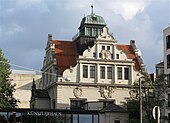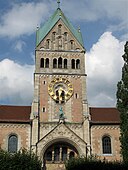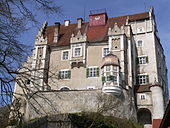|
Gabriel von Seidl
Gabriel von Seidl (9 December 1848 – 27 April 1913) was a German architect and a representative of the historicist style of architecture. Early life, education and early careerGabriel Seidl was born in 1848 in Munich, Kingdom of Bavaria. He was the first son of the wealthy baker Anton Seidl and his wife, Therese, daughter of the brewer Gabriel Sedlmayr. Seidl initially studied mechanical engineering at the Technical University of Munich (TUM). He then worked as a mechanical engineer in England, where he found that his real talent lay in the field of architecture. Consequently, he began studying at the Academy of Fine Arts in Munich. His studies were interrupted during 1870–1871 due to his volunteer participation in the Franco-Prussian War. After an extended period of study in Rome, he opened an interior decoration studio in 1878. CareerSeidl was a member of the Bavarian Arts and Crafts Association, founded in 1851, and quickly won the admiration of its members, including Lorenz Gedon, Rudolf von Seitz, and Fritz von Miller. From 1866, Seidl, like his cousin Gabriel Ritter von Sedlmayr, was a member of the Corps Germania Munich. Not only was he a faithful corps brother till his death, he also drew the plans for the construction of the corps house, overseeing the progress of the work personally. In 1900, Seidl was awarded the Order of Merit of the Bavarian Crown. Thereby, he was raised to the peerage and became Ritter von Seidl.[citation needed] In 1902, von Seidl founded the Isartalverein (Isar Valley Association), and the Who's Who of the elite Munich culture establishment soon joined.[1] The association worked for the preservation of the natural beauty of the Isar valley. The Isartalverein was founded in order to prevent further destruction of the Isar valley after the establishment of the first power plants in the Isar Valley by the electric power company Isarwerke GmbH.[citation needed] In 1903 and 1904, the first mass protests against grand engineering projects that altered ecosystems were recorded in Germany. These mass protests were publicly supported by members of the Wilhelmine elite, such as Werner Sombart, and Max Weber.[2] The Bund Heimatschutz (abbreviated BHU, Federation Homelandprotection) was, like the National Trust in Britain, assembled to appeal to as many Germans as possible. Theodor Fischer and von Seidl joined the BHU as Munich city planners and architects.[3] In 1908, he was awarded the Pour le Mérite. Seidl was made an honorary citizen of Speyer on 14 April 1909 because of his construction of a new building for the Historical Museum of the Palatinate in Speyer. In 1913, he was made an honorary citizen of Munich. Personal lifeIn 1890, Seidl married Franziska Neunzert, the daughter of a forester. Five children were born. His brother Emanuel von Seidl was also an architect, but because his work focused mainly on private residential buildings, he is not as well known today. DeatSeidl died in 1913 in his residential and office building in Munich. Gabriel von Seidl is buried at the Alter Südfriedhof in Munich. Honors
LegacyGabriel von Seidl is the namesake of the Gabriel-von-Seidl-Gymnasium in Bad Tölz. Streets or squares are named after him in Bremen, Gräfelfing, Grünwald, Nuremberg, Pullach, and Worms. The Isartalverein erected a commemorative pillar in his memory in Pullach in 1922. Selected works
See alsoReferences
Wikimedia Commons has media related to Gabriel von Seidl. |
||||||||||||||||||||||||||||













![Neubeuern Castle, construction of the middle tract,[4] 1904–1908](http://upload.wikimedia.org/wikipedia/commons/thumb/1/13/Schloss_Neubeuern-2.jpg/170px-Schloss_Neubeuern-2.jpg)






